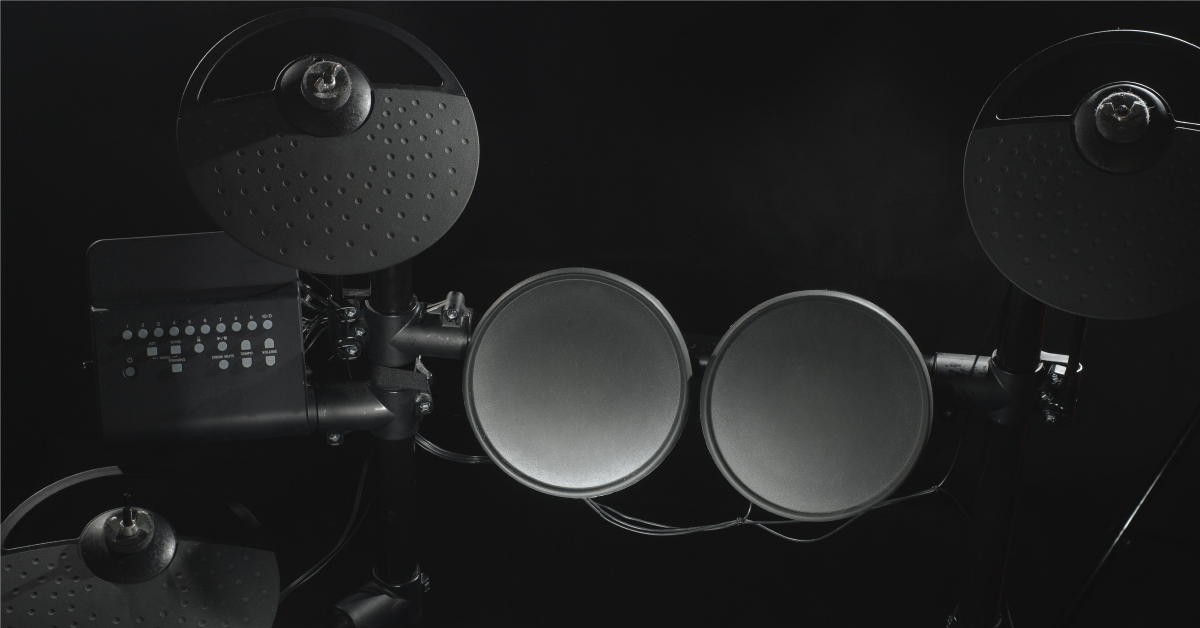How to Set up an Electronic Drum Set

In this guide, we’ll show you how to set up an electronic drum set for the first time. That means you’ll learn how to assemble the rack, connect each drum and cymbal pad, and then change the module sound settings. Continue below to get started.
- Assemble the drum rack
- How to mount electronic drum pads
- Connect the pads to the module
- Change the drum pad settings
Assemble the drum rack
IMPORTANT: Your electronic drum kit will be packed in multiple boxes and often include a parts list and diagram. Even small parts can have their own box or packaging, so take your time opening all included boxes and packaging and take stock before moving forward!
Drum racks may look a little intimidating to assemble, but it’s actually quite easy. While different electronic drum sets have different drum rack configurations, the foundation and setup is almost always the same. Refer to the Owner’s Manual for specific parts and instructions.
Electronic drum rack assembly tips
- Avoid over-tightening parts so they don’t strip.
- Save any spare parts in a dedicated drum bag or toolbox.
- Use a drum rug underneath to limit slip and prevent triggers from absorbing vibrations.
How to mount electronic drum pads
IMPORTANT: Make sure you use a plastic or rubber beater on bass drum pads, especially those with mesh heads. Felt beaters will tear through the heads due to friction and will need replacing. This type of damage is NOT covered under warranty.
Once the drum rack mount system is assembled, the next step is to attach the pads, cymbals, and module with the use of drum rack clamps and mount arms. This is a simple process, so follow these steps to secure the pads and module to the rack.
Drum pads
- Install a drum rack clamp on the rack, then tighten it down.
- Place the drum pad onto the mounting arm and tighten it down.
- Once all of the pads are mounted, adjust them to where you feel most comfortable while playing.
Cymbal pads
- Install a drum rack clamp and tighten it to the rack.
- Insert the cymbal arm into the drum rack clamp then tighten it down.
- Place the cymbal pad on the cymbal arm and use the top wing nut to tighten it down.
- If the entire cymbal pad is rubber, make sure that the logo is facing you as this is where the trigger is located.
Connect the pads to the module
While some modules use multiple TRS cable connections, most others require the use of a breakout cable. The breakout cable connection is typically located either on the back or underneath of the module. Most cables are labeled, but make sure that each cable is plugged into the correct corresponding drum or cymbal pad. Follow these instructions to get your pads connected to the module.
- Insert one end of the cable to the module. If the module uses a breakout cable, insert the breakout connector and make sure that it’s securely in place.
- Connect the other end of the cable to your drum pad.
- Most drum modules have inputs for an additional tom or cymbal, so if you want to expand your drum set in the future, connect a ¼” TRS cable to one of those inputs.
- Hi-hat triggers will have two cables; one for the pad and the other for the foot pedal. Most hi-hat pedal cables will be labeled either HHC or Hi-hat control.
- Connect your headphones to the Headphone jack or speakers to the Main Out jacks.
- If you only have one speaker, connect it to the L (mono) output jack.
- If you only have one speaker, connect it to the L (mono) output jack.
Electronic drum cable connections
Keep it neat!
Consider using plastic or Velcro cable ties to secure them to the rack. This will keep all of the cables out of the way and will make it look a lot neater.
How do drum triggers work?
Drum triggers utilize piezo sensors, determining when and how hard you strike a pad. When hit, the sensor will turn that into voltage, which is then sent to the cable. Check out our guide about how they work to learn more!
Change the drum pad settings
Once you have the drum and cymbal pads set up and connected, the last step is to change the pad settings. Unlike acoustic drums, electronic drums may require some additional adjustments. While the factory settings are a great starting point, experiment with different changes until you find the perfect balance between comfort and playability. Follow these steps to fine-tune the drum pad settings.
- Hit each pad to confirm that it’s triggering the correct drum sound.
- Begin playing and set the level on the pads, headphones, and main outputs until you find the desired volume.
- Fine-tune the following settings to fit your play-style best. Refer to the owner’s manual on how to navigate these settings.
- Sensitivity: By increasing the sensitivity, the pad will trigger louder sounds with a softer hit and decreasing it will trigger softer sounds with a harder hit.
- Threshold: When increasing threshold, the drum pad won’t trigger a sound unless until it’s hit hard enough. If it’s set too low, however, you may experience the pad trigger on its own which is known as a ghost note.
- Velocity Curve: This changes the overall response of the pad. Different settings will change the volume of the sample differently depending on how hard or soft you hit the pad.
- Hi-hat splash: When you increase this setting, tapping then releasing your foot on the hi-hat pedal will more easily trigger the hi-hat’s “splash” sound.
- Crosstalk (x-talk): Changing the crosstalk affects how it responds to vibration when another pad near it is struck. Increasing this setting is especially helpful for heavier players.
Don’t hit the pads too hard!
If you want to trigger a louder hit, don’t hit it too hard; just turn the volume of the pad up. Like any other MIDI instrument, electronic drums have a set velocity range from 0 to 127, so even if you hit the pad with a baseball bat, it will only trigger at the loudest velocity; 127.
Additional resources
Single Paradiddle Workout
Drum Limb Independence
When you need help, Sweetwater has the answers!
Our knowledge base contains over 28,000 expertly written tech articles that will give you answers and help you get the most out of your gear. Our pro musicians and gear experts update content daily to keep you informed and on your way. Best of all, it’s totally FREE, and it’s just another reason that you get more at Sweetwater.com.


